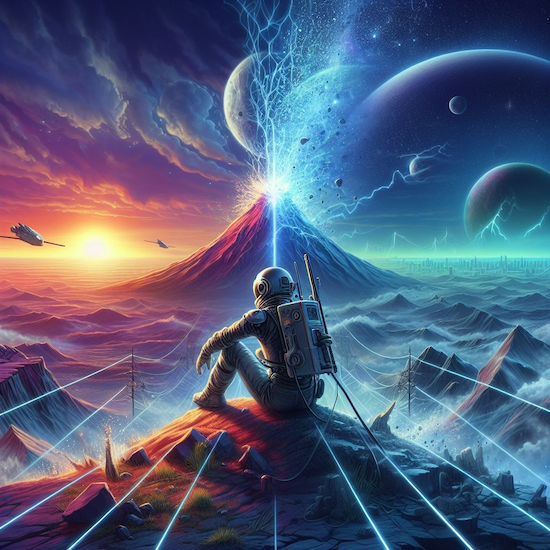 Web3 Meets Entertainment: A Seismic Shift on the Horizon
Web3 Meets Entertainment: A Seismic Shift on the Horizon
Syndicated by Brego.com
The technological revolution known as Web3 is rapidly reshaping various industries, and the entertainment sector is no exception. Built on the foundations of decentralized technologies like blockchain, cryptocurrencies, and non-fungible tokens (NFTs), Web3 promises to revolutionize the way we create, distribute, and consume entertainment content. However, this disruptive force is not without its controversies and challenges, as it ushers in a seismic shift in power dynamics within the industry.
The Convergence of Web3 and Entertainment
The integration of Web3 technologies into the entertainment industry is already underway, with innovative projects and platforms emerging across various domains. In the realm of gaming, projects like Axie Infinity, Skyweaver, and Guild of Guardians have embraced blockchain technology to create immersive virtual worlds where players can truly own and monetize their in-game assets as NFTs. These digital assets hold real-world value and can be traded or sold on decentralized marketplaces, empowering players to become stakeholders in the games they love. Similarly, in the music and film industries, Web3 is enabling new models of content distribution and monetization. Platforms like Audius and Filmio are leveraging blockchain technology to create decentralized streaming services, where artists and creators can retain greater control over their work and earn a fairer share of the revenue generated from their content.
The Shift in Power Dynamics
At the heart of this Web3 revolution lies a fundamental shift in power dynamics within the entertainment industry. Traditionally, major corporations and conglomerates have held a firm grip on content creation, distribution, and revenue streams. However, Web3 threatens to disrupt this centralized control by democratizing the entertainment landscape, placing greater power in the hands of individual creators and consumers. With Web3, artists and content creators can bypass the traditional gatekeepers and middlemen, directly connecting with their audiences and maintaining ownership over their intellectual property. This decentralized model challenges the dominance of traditional entertainment companies, potentially leading to a more diverse and inclusive creative ecosystem. Furthermore, Web3 empowers consumers to become active participants in the entertainment industry, rather than passive spectators. Through the use of NFTs and decentralized finance (DeFi) platforms, fans can invest in and support their favorite creators, artists, or projects, earning a share of the revenue and potentially shaping the direction of the content they consume.
The Controversy and Challenges
While the potential benefits of Web3’s integration into the entertainment industry are undeniable, this shift in power dynamics is not without its controversies and challenges. One of the primary concerns revolves around copyright infringement and intellectual property rights. As content becomes more decentralized and accessible, there are valid concerns about the potential for unauthorized distribution and exploitation of creative works. Additionally, the lack of centralized control and governance mechanisms in Web3 ecosystems raises questions about content moderation and accountability. How can harmful or illegal content be effectively policed in a decentralized environment where no single entity holds ultimate authority? Moreover, the technical complexities and barriers to entry associated with Web3 technologies could exacerbate the existing digital divide, potentially excluding a significant portion of the population from participating in this new entertainment landscape. Access to the necessary hardware, software, and knowledge required to navigate Web3 platforms may pose challenges for many individuals and communities.
Navigating the Uncharted Waters of Web3 Entertainment
As the entertainment industry ventures into the uncharted waters of Web3, it is crucial to address these controversies and challenges head-on. Stakeholders, including creators, platforms, regulators, and consumers, must collaborate to establish fair and ethical frameworks that protect intellectual property rights while fostering innovation and creativity. Furthermore, efforts must be made to bridge the digital divide and ensure that the benefits of Web3 entertainment are accessible to all, regardless of socioeconomic status or technological proficiency. Educational initiatives and user-friendly interfaces could play a pivotal role in democratizing access to these emerging platforms.
The Takeaway
The convergence of Web3 and the entertainment industry represents a seismic shift in power dynamics, one that has the potential to reshape the landscape of content creation, distribution, and consumption. While the decentralization of power promises to empower individual creators and consumers, it also presents a myriad of challenges and controversies that must be navigated with care. As the entertainment industry continues to evolve in this Web3 era, it is crucial to strike a balance between fostering innovation and preserving the integrity of creative works. By embracing the disruptive potential of Web3 while addressing its inherent risks and challenges, the entertainment industry can unlock a future where art, creativity, and technology coexist in harmony, delivering enriching experiences to audiences worldwide.
[/et_pb_text][/et_pb_column][/et_pb_row][/et_pb_section]